Location :
Significance of the Gurudwara
Gurudwara Fatehgarh Sahib is a complex consisting of several important shrines or Gurudwaras linked to the younger sahibzadas (younger sons) of Guru Gobind Singh. It is located about 5 km north of Sirhind, 40 Km from Chandigarh and marks the sad site of the execution in 1705 of the two younger sons of the tenth Sikh master at the behest of Wazir Khan of Kunjpura, the faujdar of Sirhind.
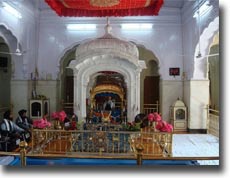
Gurudwara Burj Mata Gujri and Gurudwara Shahid Ganj are also located in the main complex of Gurudwara Fatehgarh Sahib. It was at the site of Gurudwara Burj Mata Gujri that the two younger sons Fateh Singh and Zorawar Singh of the tenth Guru and the Guru's mother Mata Gujri were kept in confinement by Wazir Khan.
The place were the three were confined is known as `THANDA BURJ' which was considered a cool place during the summer. But it was a punishment for Guru's sons and his mother to be kept here in extreme winter when the "burj" would be extreme cold. It was at this place that Mata Gujri collapsed on hearing the news of the martyrdom of her grandsons. Later on, Gurudwara Mata Gujri was constructed at this location to honour Mata ji.
Gurudwara Jyoti Sarup
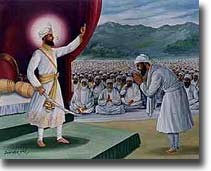
Gurudwara Shaheed Ganj
It is situated just half a kilometer from Gurudwara Fatehgarh Sahib. It commemorates the martyrdom of those Sikhs who were killed by the tyrannical Mughals. It is believed that forty cartloads of heads of martyred Sikhs were cremated here.
Shahidi Jorh Mela
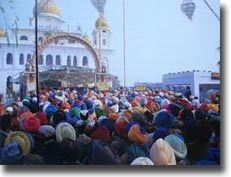
The martyrdom of the two younger sons of Guru Gobind Singh is unique in the annals of world history. The barbarious incident of bricking the two sons alive for refusing to embrace Islam took place on December 25, 1704. To commemorate the event, Shaheedi Jorh Mela is held every year at Fatehgarh Sahib from December 25th to 28th.
Palki Sahib
On the first day of the Shahidi Jorh Mela exhibits of various government agencies are put on display. Another important feature of the Jor Mela is the sound and light programme organized by the Public Relations Dept. of the state. It is a two hour light and sound programme held at the Aam Khas Bagh, Sirhind which showcases the history of Sirhind. The second day of the Jorh Mela is dominated by religio-political conferences of the various political parties of the state. The third day of the Jorh Mela is highlighted by the Nagar kirtan. The holy Guru Granth Sahib is put in a beautiful Palki placed in a well decorated special bus and carried in a procession.
The procession starts from the main Gurudwara Fatehgarh Sahib and terminates at Gurudwara Jyoti Sarup, where the Sahbizadas were cremated. This procession is symbolic of the actual cremation procession of the Sahibzadas and their grand mother.
Even though Islamic law does not allow for the killing of children, Wazir Khan gave the two young brothers a choice of either converting to Islam or being put to death. Both sons were bricked up in a wall and had their heads cut off but they steadfastly refused to convert to Islam. Guru Gobind Singhs mother Mata Gujri who had also been captured died from the shock of the murder of her beloved grandchildren.
Five years later, Banda Singh Bahadur and the Sikh army would take their revenge by destroying the town of Sirhind and killing Wazir Khan in battle.
On 11 December, they, under the orders of Waxir Khan began to be paved with bricks standing on the ground. However, as the masonry reached above chest height, it crumbled. The next day, 12 December 1705, the Sahibzadas were once again offered the choice of conversion or death.
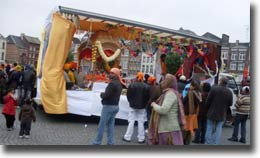
Wazir Khan was killed and the city was occupied on 14 May, 1710. Diwan Suchchanand, who had explicitly championed the penalty laid upon the captives by the faujddr, was captured and tortured to death. The town, including the Fort, was razed to the ground. A memorial was raised marking the spot where the Sahibzadas were martyred and named Fatehgarh. Sirhind, however, soon fell back into the hands of the Mughals and was later conquered by Ahmad Shah Durrani who appointed Zain Khan faujddr in 1761.
As Zain Khan was finally defeated and killed in battle on January 1764 by the Dal Khalsa and as the Sikhs occupied the country around Sirhind, no Sikh Sardar was willing to keep the accursed town.
It was consequently conferred upon Bhai Buddha Singh, a pious and humble Sikh. He later sold it to Baba Ala Singh, founder of the Patiala dynasty. To honour the memory of the young martyrs, a gurdwara was constructed on the site of the old memorial and named Fatehgarh Sahib. Maharaja Karam Singh (1798-1845) of Paliala had the gurudwara rebuilt.
| Nearby places to Fatehgarh Sahib Jalandhar Amritsar Chandigarh |
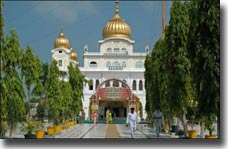 |
Transport Facilities to Sirhind:
- By Airways: Sirhind does not have an airport, and the nearest airport is Chandigarh, at a distance of 42 kms from Sirhind. Chandigarh is connected to other Indian cities.
- By Railways: Sirhind does not have a train station, and the nearest station is Fatehgarh-Sahib, at a distance of 1 kms from Sirhind.
- By Roadways: From Chandigarh To Sirhind the distance by road travel would be 42 kms.



